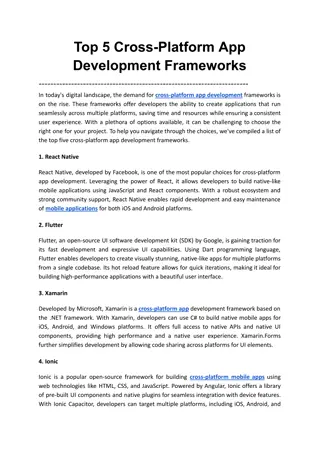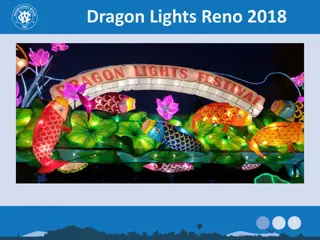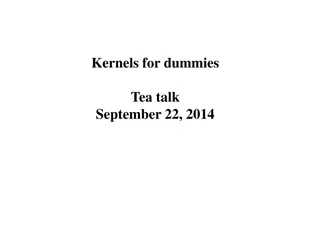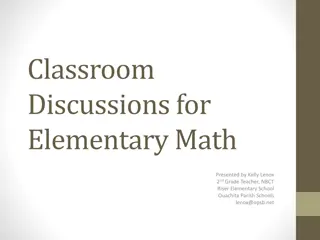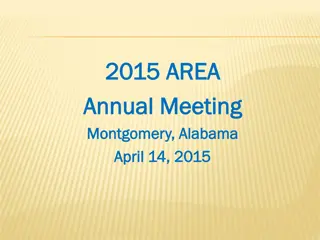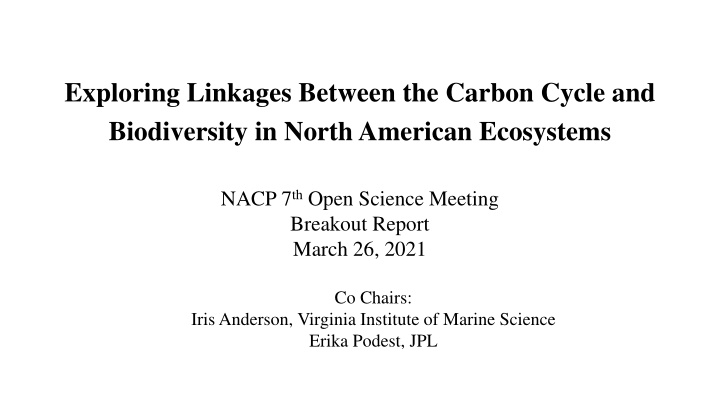
Exploring Linkages Between Carbon Cycle and Biodiversity in North American Ecosystems
This report discusses the crucial relationship between the carbon cycle and biodiversity in North American ecosystems as explored during the NACP 7th Open Science Meeting. Presenters highlighted the importance of biodiversity for climate mitigation and carbon sequestration in terrestrial and marine environments. Key gaps in knowledge regarding ocean and terrestrial processes were identified, emphasizing the need for data on impacts of climate change on ecosystems, habitat loss responses, and the role of biodiversity in carbon storage.
Download Presentation

Please find below an Image/Link to download the presentation.
The content on the website is provided AS IS for your information and personal use only. It may not be sold, licensed, or shared on other websites without obtaining consent from the author. If you encounter any issues during the download, it is possible that the publisher has removed the file from their server.
You are allowed to download the files provided on this website for personal or commercial use, subject to the condition that they are used lawfully. All files are the property of their respective owners.
The content on the website is provided AS IS for your information and personal use only. It may not be sold, licensed, or shared on other websites without obtaining consent from the author.
E N D
Presentation Transcript
Exploring Linkages Between the Carbon Cycle and Biodiversity in North American Ecosystems NACP 7th Open Science Meeting Breakout Report March 26, 2021 Co Chairs: Iris Anderson, Virginia Institute of Marine Science Erika Podest, JPL
Breakout ~25 Attendees Presenters: Dr. Rebecca Shaw, Chief Scientist, WWF Discussed biodiversity/carbon related to terrestrial ecosystems. Stressed on the importance of biodiversity as a nature based solution for climate mitigation. Dr. Deborah Steinberg, Professor of Marine Science & Chair, Department of Biological Sciences, Virginia Institute of Marine Science Discussed the ocean biological pump and the role of biodiversity in carbon sequestration through fecal matter.
Gaps in Knowledge: Ocean Processes What are the impacts of predicted weakening of the Gulf Stream on the biological pump and biodiversity in the North Atlantic? Need for time-series data. How will the abundance, diversity, and size range of plankton shift as the ocean warms? For example, will there be fewer and smaller copepods and, thus, fewer and smaller fecal pellets which provide a key mechanism for moving carbon to deep water? Current data suggest that there will be. Will warming or ocean acidification increase blooms of gelatinous organisms (medusae, salps), which play an important role in ocean C cycling? What about the role of higher trophic levels such as fishes and larger gelatinous zooplankton in the ocean C cycle? How do processes in the ocean mesopelagic zone (twilight zone) affect C storage in the ocean? Dr. Steinberg here stressed the importance of time-series data to document change and validate models. How do terrestrial carbon flows support and influence biodiversity along coastal margins and in the ocean and what can be done to better manage these flows to support carbon sequestration.
Gaps in Knowledge: Terrestrial Processes What trends need to be reversed with regard to biodiversity in order to support functioning of ecosystems and C sequestration? What should be the most important consideration regarding response to loss of habitat-- restoration vs. resilience? Ex. Is it better to plant a palm forest which can rapidly sequester C, but may be less resilient than a more diverse forest? Biodiversity increases resilience but not necessarily C storage how true is that? How do environmental factors impact resilience vs. C storage? Several initiatives have been proposed to mitigate climate change; for example, the Half Earth initiative (E.O Wilson Biodiversity Foundation) and the 30 x 30 Movement (The Wilderness Society). How should sites be chosen to maximize outcomes? Will these initiatives to set aside protected areas protect diversity as well as C storage? Soil C holds 4x as much as carbon as plant biomass in terrestrial systems. What are the implications of microbial biodiversity in soils to carbon sequestration? What are the best strategies for responding to habitat loss from extreme events such as wildfires or hurricanes? How are invasive species affecting biodiversity and can this change affect the ability of ecosystems to store carbon? Does a certain level of plant diversity increase carbon accumulation and does this differ between grasslands, forests, and wetlands?
Take Home Message We currently lack sufficient knowledge about the relationship between carbon and biodiversity in terrestrial and aquatic ecosystems. Of particular interest are the effects of climate change on the relationship between biodiversity and carbon sequestration, especially on the long term storage of carbon. Climate mitigation actions should account for the role of biodiversity in the storage of carbon. There is a need for better models and better monitoring to detect changes over longer time scales.
Recommendations Different U.S. Programs (e.g. NSF, NASA, NOAA, USGS) should consider calls addressing the linkages between carbon and biodiversity.
Thank you Iris Anderson, iris@vims.edu Erika Podest, erika.podest@jpl.nasa.gov



